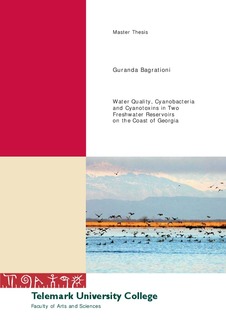Water Quality, Cyanobacteria and Cyanotoxins in Two Freshwater Reservoirs on the Coast of Georgia
Master thesis
Published version
Permanent lenke
http://hdl.handle.net/11250/2438962Utgivelsesdato
2016-01-18Metadata
Vis full innførselSamlinger
Originalversjon
Bagrationi, G. Water Quality, Cyanobacteria and Cyanotoxins in Two Freshwater Reservoirs on the Coast of Georgia. Master thesis, Telemark University College, 2015Sammendrag
Cyanobacteria constitute a diverse group of photoautotrophic bacteria that inhabit a wide range of aquatic and terrestrial environments. Several aquatic bloom-forming species of cyanobacteria produce toxic secondary metabolites that are hazardous to humans and animals. This thesis presents the study of cyanobacterial communities and cyanotoxins in relation to water quality parameters in two coastal lagoons - Lake Paliastomi and Lake Nurigeli situated in Georgia. Microscopic, immunological (ELISA) and molecular techniques (PCR) combined with physical-chemical parameters were applied to evaluate ecological conditions of Lake Paliastomi and Lake Nurigeli with the focus on cyanobacteria and cyanotoxins. Cyanobacteria species identified by microscopy in these lakes belong to genera Anabaena, Anabaenopsis and Microcystis. Microscopic analyses were in accordance with PCR amplification, which was positive for oxyphotobacteria specific primers. Negative results on PCR when amplifying mcy gene regions could also be linked to low concentrations of microcystin. Toxin analyses demonstrated low concentrations of microcystin and saxitoxin and high concentrations of anatoxin-a in two lakes. On the bases of total phosphorus concentrations (0,1-0,2 mg/L), temperature (25,2 - 29,2°C) and pH (7,4- 9,2) Lake Paliastomi and Lake Nurigeli provide good environments for cyanobacteria.
